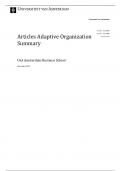Universiteit van Amsterdam
T 020 – 525 0000
F 020 – 525 0000
Articles Adaptive Organization www.uva.nl
Summary
UvA Amsterdam Business School
December 2023
,Table of contents:
• Week 1: Foundations of Adaptation
- Morgan, G. (2006). Images of Organization.
- Abatecola, G. (2014). Research in organizational evolution: What comes next?
- Feldman, M. S., & Pentland, B. T. (2003). Reconceptualizing Organizational Routines as a
Source of Flexibility and Change.
- Burgelman, R. A. (1991). Intraorganizational Ecology of Strategy Making and Organizational
Adaptation: Theory and Field Research.
• Week 2: Drivers of Adaptation
- Argote, L., & Epple, D. (1990). Learning Curves in Manufacturing. Science, 247(920-924).
- Greve, H. R. (2003). A Behavioral Theory of R&D Expenditures and Innovations: Evidence
from Shipbuilding. Academy of Management Journal, 46(6), 685-702.
- Leonard-Barton, D. (1992). Core Capabilities and Core Rigidities: A Paradox in Managing New
Product Development. Strategic Management Journal, 13, 111-125.
- Levinthal, D. A., & March, J. G. (1993). The Myopia of Learning. Strategic Management
Journal, 14, 95-112.
• Week 3: Capabilities for Adaptation
- Agarwal, R., & Helfat, C. E. (2009). Strategic Renewal of Organizations. Organization Science,
20(2), 281-293.
- Teece, D. J., Peteraf, M., & Leih, S. (2016). Dynamic Capabilities and Organizational Agility.
California Management Review, 58(4), 13-35.
- Eisenhardt, K. M., & Martin, J. A. (2000). Dynamic Capabilities: What Are They? Strategic
Management Journal, 21(10/11), 1105-1121.
- Zahra, S. A., & George, G. (2002). Absorptive Capacity: A Review, Reconceptualization, and
Extension. Academy of Management Review, 27(2), 185-203.
• Week 4: Organizing Adaptation
- Lawrence, P. R., & Lorsch, J. W. (1967). Differentiation and Integration in Complex
Organizations. Administrative Science Quarterly, 12(1), 1-47.
- Stan, M., & Puranam, P. (2017). Organizational Adaptation to Interdependence Shifts: The Role
of Integrator Structures. Strategic Management Journal, 38(5), 1041-1061.
- Jansen, J. J. P., Tempelaar, M. P., van den Bosch, F. A. J., & Volberda, H. W. (2009). Structural
Differentiation and Ambidexterity: The Mediating Role of Integration Mechanisms. Organization
Science, 20(4), 797-811.
- Gibson, C. B., & Birkinshaw, J. (2004). The Antecedents, Consequences, and Mediating Role of
Organizational Ambidexterity. Academy of Management Journal, 47(2), 209-226.
2
, Week 5: Managing Adaptation I
- Zahra, S. A., Nielsen, A. P., & Bogner, W. C. (1999). Corporate Entrepreneurship,
Knowledge, and Competence Development. Entrepreneurship Theory and Practice, 23(3),
169-189.
- Wolcott, R. C., & Lippitz, M. J. (2007). The Four Models of Corporate Entrepreneurship.
MIT Sloan Management Review, 49(1), 75-82.
- Schildt, H. A., Maula, M. V. J., & Keil, T. (2005). Explorative and Exploitative Learning
from External Corporate Ventures. Entrepreneurship Theory & Practice, 29(4), 493-515.
- Shankar, R. K., & Shepherd, D. A. (2019). Accelerating Strategic Fit or Venture
Emergence: Different Paths Adopted by Corporate Accelerators. Journal of Business
Venturing, 34(5), Article 105886.
Week 6: Managing Adaptation II
- Kotter, J. P. (2001). What Leaders Really Do. Harvard Business Review, 79(11), 85-96.
- Ling, Y., Simsek, Z., Lubatkin, M. H., & Veiga, J. F. (2008). Transformational
Leadership’s Role in Promoting Corporate Entrepreneurship: Examining the CEO-TMT
Interface. The Academy of Management Journal, 51(3), 557-576.
- Ren, C. R., & Guo, C. (2011). Middle Managers’ Strategic Role in the Corporate
Entrepreneurial Process: Attention-Based Effects. Journal of Management, 37(6), 1586-
1610.
- Nadkarni, S., Chen, T., & Chen, J. (2016). The Clock is Ticking! Executive Temporal
Depth, Industry Velocity, and Competitive Aggressiveness. Strategic Management
Journal, 37, 1132-1153.
3




